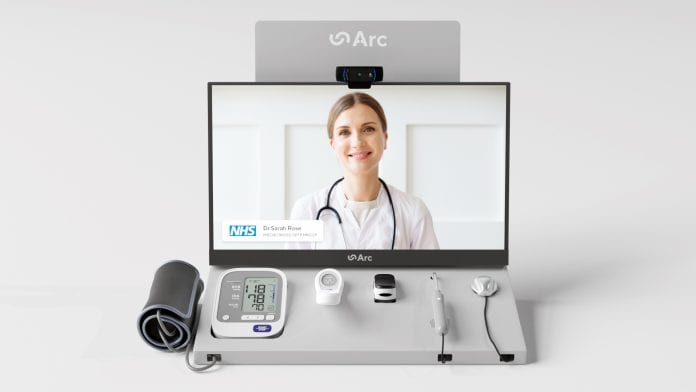
Dr Zubair Ahmed, CEO of Arc Health, discusses how the company is leading the charge in digital diagnostics.
In light of COVID-19 the medical world has faced unprecedented challenges, especially when required to treat those most vulnerable to the virus, the elderly and those living with comorbidities. In order to help clinicians efficiently navigate these factors, Arc Health have created a remote diagnostics tool that could change the face of modern healthcare.
Prior to the outbreak, only four million of the roughly 30 million GP appointments that were held in the UK were remote, this number has risen to around 11 million between October 2019 and February 2021. With such a sharp uptick in remote appointments, it has been crucial that providers examine ways to keep up with this demand and look at ways to make remote appointments accessible for their most vulnerable patients. This is of particular importance when caring for residents in care homes. Recent COVID restrictions mean visitors to the majority of care homes are required to take a lateral flow test prior to entering, adding an extra 30 minutes onto the existing appointment time, and reducing the number of patients one practitioner can assess within a day. Remote examinations would ensure that all residents, care staff and medical practitioners are protected whilst still enabling those residents to receive high quality care.
Whilst remote consultation had been established prior to the outbreak of COVID-19, it has evolved rapidly since the start of the pandemic and continues to do so. Originally, remote consultation consisted primarily of telephone consultations for minor illnesses, however, since access to in-person appointments has been severely limited due to restrictions, video consultation has taken centre stage.
Video consultation has the increased benefit of allowing for better interpersonal connections between patient and clinician, as well as allowing visual examination of ailments such as cuts or rashes and further allowing doctors to lead patients in self-examinations, ensuring any symptoms or measurements that are self-reported are as accurate as possible. However, video consultation is not without its faults, it cannot accommodate highly accurate or hyper specific examinations such as taking temperatures, measuring blood pressure or examining ears, nose or throat, limiting the number of cases that can accurately be assessed without face-to-face appointments. Arc Health have recognised the issues facing video consultation and have developed a product that enables high accuracy, clinical level readings to be administered remotely, with real-time data being sent back to the presiding clinician who can analyse the data immediately and establish the need for treatment, whether it be further referrals or prescription medications. Health Europa Quarterly (HEQ) speaks to the CEO of Arc Health, Dr Zubair Ahmed, to find out more.
To begin, can you give me an overview of Arc Health and its main aims/objectives?
Arc Health was founded to enable the NHS to see patients remotely whilst ensuring diagnoses are still as accurate and as safe as possible. The need for this evolution in patient facing care has only been accelerated by the pandemic when it quickly became apparent that objective measurements would be required in order to manage patients, whilst ensuring both patients and practitioners are kept safe. The aim of Arc Health is to go beyond what is currently possible with video consultations, by providing greater access to connected devices, enabling healthcare professionals to perform full clinical examinations remotely, protecting at-risk patients and reducing the distress caused by lengthy hospital trips and appointments. With Arc Health technology, highly vulnerable and complex patients in care homes can get access to high-quality care faster, shifting care closer to home and reducing avoidable hospitalisation, enhancing quality of life and decreasing the strain on health services.

Arc Health ensures residents can get timely access to high-quality care at their home
What are the benefits of remote examination technology?
Whilst millions of patients have benefited from video consultations throughout the pandemic, it is important to understand that it is a system that is not without its shortcomings. Without the capability to physically examine, healthcare professionals cannot fully assess the patient and instead must rely on self-reporting from patients who may have little to no medical knowledge. As a result, the illnesses that could be accurately assessed without examination accounted for less than 40% of required consultations. However, through our remote examination technology, clinicians can see the whole patient and receive live diagnostic feedback, allowing healthcare professionals to manage 94% of consultations remotely using Arc Health’s remote examination technology.
How does the diagnostic technology work, and what tools are included to help clinicians perform remote examinations?
Arc Health comes equipped with connected devices, including an integrated stethoscope, blood pressure monitor, pulse oximeter, thermometer and close examination camera. With easy, streamlined operation this technology allows healthcare professionals to perform a full clinical examination remotely during a video consultation, with the carer or patient simply administering tests whose results are instantly relayed back to the doctor. For example, clinicians can auscultate heart and lung sounds with the connected stethoscope, perform ENT assessments with a remote otoscope and measure observations such as temperature, pulse rate, blood pressure and oxygen saturations, all without any extraneous travel or admin and whilst ensuring the safety of vulnerable patients.
How could the wider adoption of remote examination technologies improve healthcare delivery?
Adopting remote examination technologies, such as Arc Health, can improve the cost-effectiveness of the healthcare system by saving clinician time through minimising home visits and reducing appointment times, therefore allowing more patients to be treated each day. It can also help in avoiding unnecessary trips to A&E through allowing the clinician to objectively examine patients and accurately assess their level of risk, therefore reducing hospital admission rates through means of early intervention. Arc Health ensures residents can get timely access to high-quality care in their home, in line with the guidance established by the Enhanced Health for Care Homes framework. Meanwhile, clinicians get high-quality, innovative remote patient management and spend less time travelling and more time helping those in need. These remote capabilities enable the care community to reduce inappropriate A&E admissions therefore reducing hospitalisation and minimising infection risk from diseases including COVID-19.
How do you see Arc Health progressing in the future? Do you plan to expand your range of products?
As we move into the future Arc Health is working to develop integrated patient records, allowing clinicians to streamline the treatment process. We are also working towards enhanced cardiovascular and respiratory management through the incorporation of an ECG, a peak flow meter and a spirometer. Moreover, we plan to incorporate continuous glucose monitoring, INR monitoring and continual vital sign monitoring, allowing clinicians to enhance the quality of care they can remotely offer to their patients.
Dr Zubair Ahmed
CEO
Arc Health
www.archealth.io
This article is from issue 18 of Health Europa. Click here to get your free subscription today.







